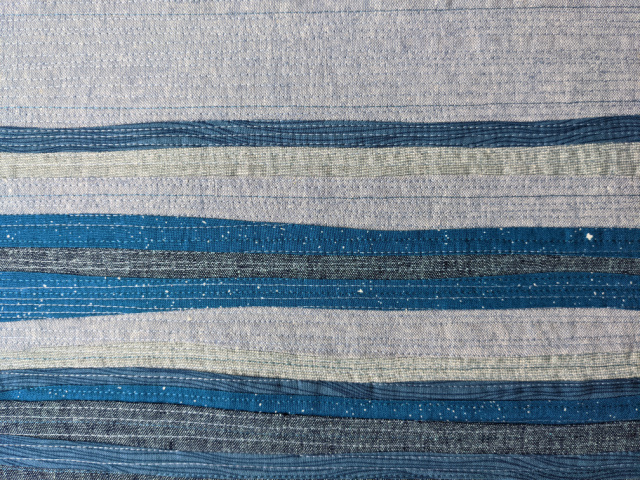So having finished my latest Dropcloth sampler, and with no quilts to bind, I needed a handwork project to work on during QuiltCon lectures. I happened across the Patchwork Sashiko booklet I'd purchased from Banjo Flannel a few months ago and decided now was the time.
The process is similar yet quite different from the
Kawandi quilt I made last fall. Or should I say, it
looks somewhat similar, but in fact there are a few key differences. First off, all the patchwork pieces are cut before beginning for the
patchwork sashisko method. I cut mine all from scraps, 1.5" x 1.5" squares and 1.5" x 2" rectangles. Then the fabric shapes are actually arranged on top of a muslin backing, then secured with pins and basted before any stitching begins.
So here's my finished, quilted piece, with basting and quilting lines removed. It measures just slightly larger than 6.5" x 9.75".
Note that in addition to the quilting lines, there are additional little stitches to secure the occasional loose edge of fabric; and because they seemed to 'fit,' there are a handful of 'x' stitches here and there as well.
Soooo.... the main reason I thought to try Banjo Flannel's patchwork sashiko methoed was a cute little draw-string pouch I'd seen - I'm not even sure where! But it's the
Pita Pocket Pouch, with the hand-stitched fabric panel for the front, and Essex linen on the back.

Super cute!
I made mine just a little larger than the pattern, just so I didn't trim off any more of that hand-stitching than was necessary. A piece of lightweight fusible interfacing was pressed on the back of the piece before trimming to size; and I also went so far as stitching a very tight machine stitch around the whole perimeter before constructing the bag.
This and several other patterns for things to do with patchwork sashiko are on the
Banjo Flannel site. Do note that the fabric patches are raw-edge clear to the end of the project - another key difference from the Kawandi. But with all that hand-stitching, I'm confident the little pouch will hold up well for quite a while. And the occasional loose thread just adds to the bag's character, don't you think?





























